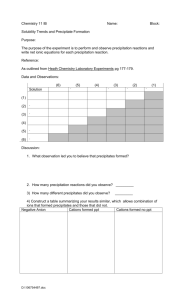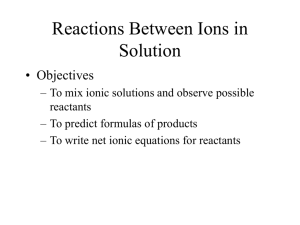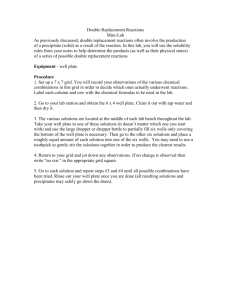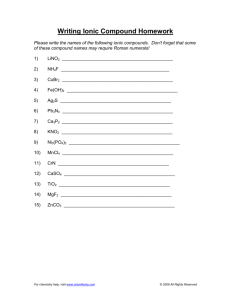Precipitation reactions
advertisement
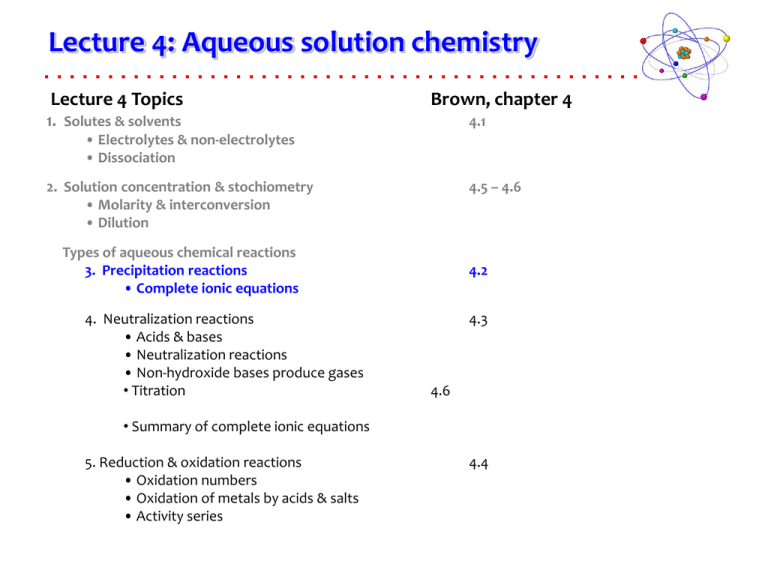
Lecture 4: Aqueous solution chemistry Lecture 4 Topics Brown, chapter 4 1. Solutes & solvents 4.1 • Electrolytes & non-electrolytes • Dissociation 2. Solution concentration & stochiometry • Molarity & interconversion • Dilution 4.5 – 4.6 Types of aqueous chemical reactions 3. Precipitation reactions • Complete ionic equations 4. Neutralization reactions • Acids & bases • Neutralization reactions • Non-hydroxide bases produce gases • Titration 4.2 4.3 4.6 • Summary of complete ionic equations 5. Reduction & oxidation reactions • Oxidation numbers • Oxidation of metals by acids & salts • Activity series 4.4 Precipitation reactions: solids from solutions Unpredictable, so use the solubility chart. Complete & net ionic equations describe the action. Acids cause precipitates to dissociate. Types of aqueous chemical reactions 1. 2. 3. Precipitation Acid-base Oxidation-reduction p. 124-6 Precipitation: They just can’t let go! Precipitation: 2 clear ionic solutions are mixed and form a solid product that ‘precipitates’ (or falls out) of solution & settles to the bottom But we just learned that ionic compounds dissociate in water! Why don’t these ionic compound stay in solution? Some ionic pairs are so strongly attracted to each other that they don’t dissociate in water. (The Romeo & Juliet of ions!) • How do we know which pairs suffer from this amazing attraction? • Use the solubility table! This table is arranged by ANION. So find the anion of the product that will be formed by your rxn. Upper half: anions produce soluble products unless with Ag, Hg, Pb. Lower half: anions produce insoluble products (or precipitates) unless with the cations listed. Alkalai = column 1A Alkalai earth = column 2A p. 126-8 Examples: precipitation reactions 1. 2. Predict the products & balance the equation. Do any products precipitate? Pb(NO3)2(aq) + 2 Kl (aq) Predict by exchange & use the solubility table! PbI2 (s) + 2KNO3 (aq) Mix Mg(NO3)2 and NaOH. Mg(NO3)2(aq) + 2NaOH(aq) Mg(OH)2(ppt) + 2NaNO3(aq) Mix AgNO3 and KCl. Ag(NO3)(aq) + KCl(aq) AgCl(ppt) + KNO3(aq) Mix NaC2H3O2 and K2CO3. 2Na(C2H3O2)(aq) + K2CO3(aq) Na2CO3(aq) + K2(C2H3O2)(aq) So this last rxn does NOT produce any precipitates. p.125-6 Complete ionic equations To write a complete ionic equation, dissociate all of the soluble ionic compounds, leaving only the solids (or precipitates) together. Pb(NO3)2(aq) + 2Kl (aq) PbI2 (s/ppt)+ 2KNO3 (aq) Pb+2 (aq) + 2NO3-1(aq) + 2K+1 (aq) + 2l-1(aq) +2 -1 +1 -1 CIE Pb (aq) + 2NO3 (aq) + 2K (aq) + 2l (aq) Pb+2 (aq) + 2l-1(aq) PbI2 (s/ppt)+ 2K+1 (aq) + 2NO3 (aq) PbI2 (s/ppt)+ 2K+1 (aq) + 2NO3 (aq) PbI2 (s/ppt) Net ionic equation Ions that are found in exactly the same form on both sides of the equation are spectator ions. These ions don’t participate in the formation of the insoluble (ppt) product, rather they just dissociate, and then hang out and watch the action. • Spectator ions cancel out, just like identical terms in a mathematical operation. • The net ionic equation is left, describing what’s really going on in the reaction; describing the real changes occurring. Predict products, balance the equation, write complete & net ionics: BaCl2 + K2SO4 Ba+2 + 2Cl-1 + 2K+1 + SO4-2 --> BaSO4(ppt) + 2K+1 + 2Cl-1 Fe2(SO4)3 + LiOH 2Fe+3 + 3SO4-2 + 6Li+1 + 6OH-1 --> 6Li+1 + 3SO4-2 + 2Fe(OH)3(ppt) p.127-9 Can anything break up precipitates? While water has no effect on precipitated solids, acids can break them up into ions again. p.133
